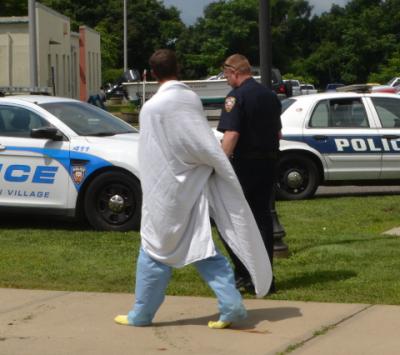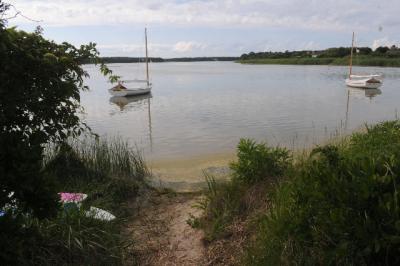Motorcyclists Call for ‘Justice’ for One of Their Own
Motorcyclists Call for ‘Justice’ for One of Their Own

Members of motorcycle clubs from across the East End gathered in East Hampton Town Justice Court last Thursday morning to show support for a fellow cyclist, Sidney R. Hughes, 37, of Montauk, who was seriously injured on June 21 when struck by Jason Monet’s BMW. East Hampton Town police charged Mr. Monet, of Stamford, Conn., with drunken driving after the accident.
The club members, from Enders East and Enders West, the Road Reapers, Bikers for Christ, and Long Island Abate, looked on as Mr. Monet, 43, made a required court appearance. He currently faces a single misdemeanor charge of driving while intoxicated, but his case is before a grand jury, which could indict him on additional charges including felony assault.
“I just want to see justice done,” said a member of the Road Reapers of Riverhead, who identified himself as Russ. “I don’t want to see it get swept under the rug.”
“When motorcyclists are hit, the punishment should be the same as when a child gets hit,” said Jim Barr, president of Long Island Abate, a club dedicated to making drivers more attentive to vulnerable motorcyclists.
Mr. Monet stood before East Hampton Town Justice Steven Tekulsky as Sean McDonnell, an assistant district attorney, informed the court of the grand jury proceedings. If felony charges are brought, the case will be moved to State Supreme Court, either in Riverside or Central Islip.
After the brief session, the club members left the courthouse and rode out to visit Mr. Hughes, who has undergone several surgeries with more to come. He may never regain full use of his left leg.
Lying on a couch in his living room, he said he could not recall much about the accident. “I just remember the sound of it happening. He pulled right in front of me.”
Police said Mr. Monet had been headed west on Napeague, near Cyril’s, when he veered left across the highway near the entrance to the Ocean Vista resort, where he was staying. “I was arguing with my girlfriend and I went to turn into the motel parking lot and I didn’t see the guy on the motorcycle,” he later told police.
The eastbound motorcycle skidded across the road, throwing its rider about 100 feet. He was unconscious when police found him.
“They said I lost 50 percent of my blood by the time I got to the hospital,” Mr. Hughes said. He suffered a severe compound fracture of his left femur, two broken bones in the lower leg, a badly fractured ankle, a fractured wrist and thumb, and a dislocated hip.
A Suffolk County helicopter flew him to Stony Brook University Hospital. In his first days there, when he was conscious, he complained of searing pain in the hip area. Doctors at first attributed it to the dislocation, but eventually discovered that a piece of the BMW had lodged under his skin. It was surgically removed.
A friend and fellow member of Enders East MC, Justin Portell, took cellphone photos of the injuries in the hours and days after the crash. They show Mr. Hughes’s face swollen and blackened with bruises. One eye socket was damaged, an injury that is still awaiting repair. During the first week of his hospital stay, Mr. Hughes was unable to see.
Six weeks later, his left leg held together with pins and rods, he still takes six oxycodone pills a day, down from 10. Once a day he has to inject himself in the stomach with an anti-blood-clotting drug. The hardest part of the day, he said, is just after waking up.
The cyclists questioned the handling of the case, saying Mr. Monet should have been charged with leaving the scene of an accident. Mr. Portell claimed that he drove into the resort’s parking lot after the crash and parked up against shrubbery, concealing the BMW’s damaged front end, and that he was not in the car when police found him.
The club members suggested that police treat motorcyclists differently from other victims of road accidents.
Capt. Chris Anderson of the town police denied that assertion this week. The department handles each accident involving injury in the same way, he said, devoting a great deal of time and resources no matter who is involved.
As Mr. Hughes lay on the couch last Thursday, his friends were dismantling what was left of his beloved 2004 Yamaha Midnight Star 1700. “It’s totaled. Snapped the frame right behind the gooseneck,” said a member of Enders West. Mr. Hughes was giving what was still usable to a man who has a similar model.
“Make sure you put those parts to good use,” Mr. Hughes said as the men got set to leave. “You guys all ride safe.”
“Anything you need, we’ll be here,” came the reply.
Later, speaking with Mr. Portell and his wife, Dawn, Mr. Hughes said he owed his life to a guest at the Ocean Vista who had called 911 on the night of the accident and a couple who had covered him with a blanket as he lay bleeding on the gravel.
“I’d love to know who it was, so I could thank them myself,” he said. “I had a guardian angel on my side.”



